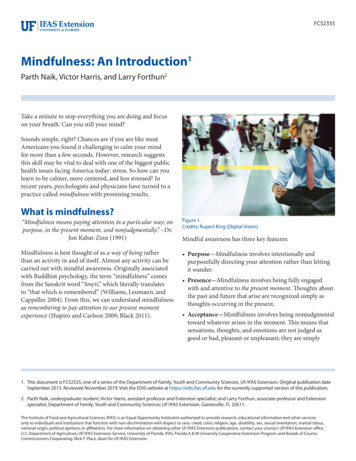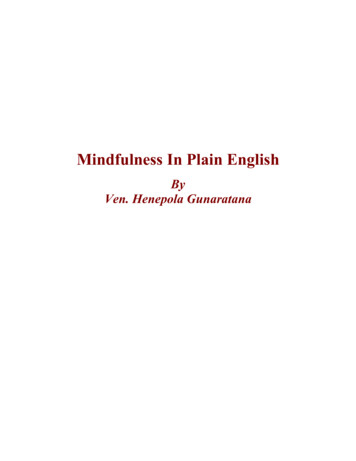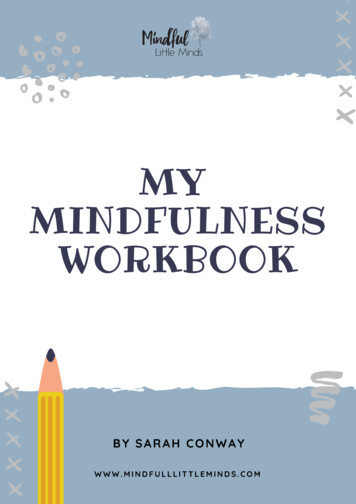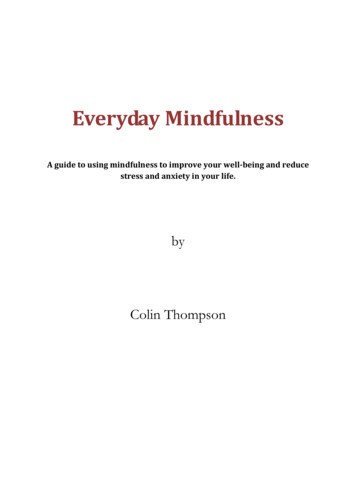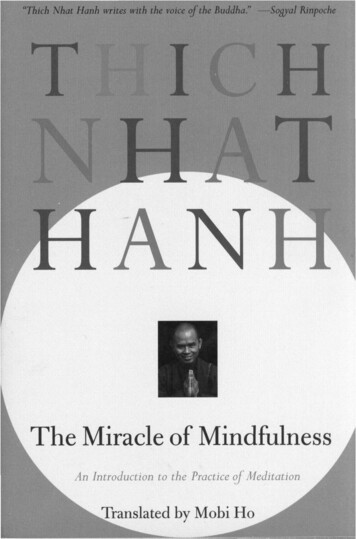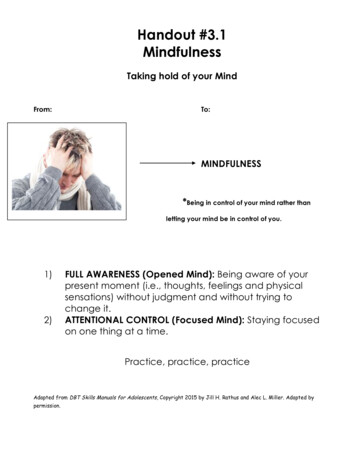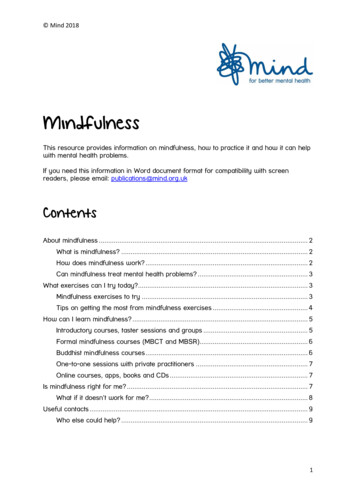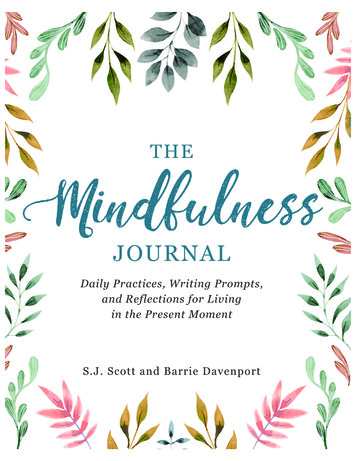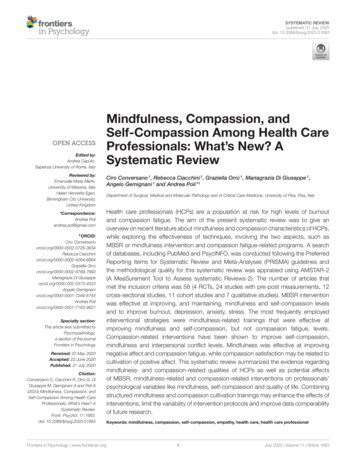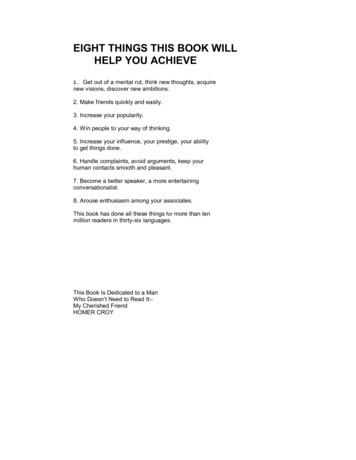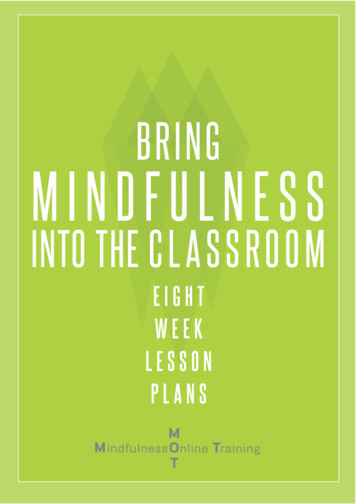
Transcription
BRINGMINDFULNESSINTO THE C L A S S R O O MEIGHTWEEKLESSONPLANSMM indfulness Online TrainingT
ContentINTRODUCTION.3ABOUT THE AUTHOR .5LESSON ONE-Finding Our Inner Anchor . 6LESSON TWO – Mindfulness of Emotions . 12LESSON THREE – Mindful Thinking and Our Brains. 16LESSON FOUR – Heartfulness & Loving Kindness . 20LESSON FIVE- Interconnectivity .24LESSON SIX- Slow Motion. 28LESSON SEVEN- Liking & Disliking – Letting Go . 31LESSON EIGHT- Visualisation . 34APPENDIX 1 - Cloud & Te Whare Tapa Wha .37APPENDIX 2- The Mindometer . 40APPENDIX 3- Mind Jar & The Brain House . 41APPENDIX 7- Emotions Chart. 45 Mindful NZ Schools Rita Riccola 2017All Rights Reserved. No part of this book may be reproduced in any form or by any means withoutpermission from the author.Except for your personal and professional usewww.mindfulnzschools.co.nz
B R I N G I N G M I N D FU L N E SS T O TH E C L ASS R O O MIntroduction“We ask students to pay attention all day,yet we never teach them HOW”(Dr. Amy Saltzman).Ongoing research points to the need for all students to receive some form of mentaltraining to fulfil their educational and personal potential.This complete 8-week course in Mindfulness Facilitation to students and children isbased on the successful programme Mindful NZ Schools has been running the pastfour years as well as latest research and techniques on teaching mindfulness designedby the original MBSR members who trained with Jon Kabat-Zinn.The course is designed as a lesson-by-lesson process of delivering Mindfulness classesto both primary or secondary students. Each week’s lesson provides detailed contentand delivery suggestions.These lesson plans gives you a resource to improve students ability to deal with stressand anxiety as well as improve attention and focus and cultivate kindness and empathy.Each week you will find different activities and practices to help engage students inthe mindfulness process and assist in internalising the mindfulness process. In addition audio files are provided to reinforce the daily practice.The lessons are designed by a registered teacher and complies with the objectives ofthe curriculum for personal development, including a focus on social and emotionaldevelopment, personal self-regulation and building resilience- qualities recognised asbenchmarks for success in life.Studies have shown that social behaviour and academic achievement increase significantly among students who have received Mindfulness instruction. Mindfulness hasbeen proven to help children make sense of their emotions and the world aroundthem.In our fast paced world, where the increasing demands of living, places enormousstress on all people, children, teenagers and adults, the purposeful, daily cultivation ofconnection to self, others and the world around us has been proven to assist mental,emotional and physical balance.
BRING MINDFULNESS TO THE CLASSROOMINTRODUCTIONBenefits such as: Decreased stress and anxiety Better sleep Better self-management Less reactivity Improved mental resilience Increased self-awarenessare commonplace when you practice Mindfulness regularly.Your Own PracticeMindfulness can’t be learnt by talking or reading about it. Mindfulness is experiential. Tobe able to teach mindfulness you need to understand how it works from the inside out.This course is aimed at individuals who have an established mindfulness/meditationpractice (see PART 1 of the course) and want to offer these beneficial, simple practicesfor others; weather it is in the workplace, the classroom or community group.The more anchored you are in your own regular mindfulness practice, the better youwill be able to convey these exercises and appreciate where studens are in the processand better aswering questions from your own mindfulness experience rather thanhaving to fall back on what you’ve read.If you don‘t have establish a mindfulness practice yet, it is highly recommended tostart with the 8 week online mindfulness course that is included in this course.-4-
BRING MINDFULNESS TO THE CLASSROOMINTRODUCTIONAbout the AuthorRita Riccola is a NZ Teacher and a trained Mindfulness teacher with 25 yrs experience who has completed courses with Mindful Schools USA and attended many Mindfulness retreats. Rita has designedthese courses to meet the growing need for educators and human resource workers to offerMindfulness training to all interested. The courses are continually well-received by many participants inNZ and Australia. She has provided training for schools in Auckland and trained teachers at DiocesanSchools for Girls and Dilworth Junior College.-5-
BRING MINDFULNESS TO THE CLASSROOMLESSON PLAN WEEK ONELesson One- Finding Our Inner AnchorLEARNING OUTCOMES:1. Students will learn to do the mindfulness practices.2. Students will be able to talk about what mindfulnessis and identify what present moment awareness is.3. Students will become familiar with Te Whare Tapa Wha.LEARNING AIMS:1. To learn the mindfulness practices.2. Learning to understand what mindfulness is andhow it can help our livesPURPOSE: To provide students with strategies to identifyfactors that affect their personal, physical, socialand emotional growth. To establish mindful class behaviour and guidelines. To Identify what mindfulness is; non-judging,present moment awareness. To learn about the ‘mindful body’. To learn mindful breathing. To learn about Te Whare Tapa Wha-the house with four walls.LINKS WITH CURRICULUM ACHIEVEMENT OBJECTIVESPersonal growth: ‘To identify factors that affect theirpersonal, physical, social and emotional growth and todevelop skills to manage changes.’ (Level 3)Physical activity: ‘Maintain regular participation inenjoyable physical activities in a range of environments anddescribe how these assist the promotion of wellbeing.’ (Level 5)Personal identity: Describe how their own feelings,beliefs and actions and those of other people contributeto their personal sense of self-worth. (Level 3)Social Studies: Understanding that different cultures havedifferent practices but reflect similar purposes. (Level 3)CLASS GUIDELINESTo practice mindfulness and really experience the benefits you need to really listen toyour teacher and be still and quiet. There will be some times when we can talk andshare our experiences and thoughts about mindfulness. You don’t have to speak if youdon’t want to but listen quietly when others are speaking.Be respectful, that is really listen, don’t interrupt others, no silly behaviour or showingoff. If the teacher raises his/her hand everyone needs to stop and take 3 deep breaths.Let’s make a list of the benefits on the board; Less stress & anxiety Clearer thinking Better able to notice and pay attention Less anger, annoyance and reactivity Go to sleep easier- not lay awake thinking Be kinder and more caring to people & yourself Feel more connected to the people, nature and the world around you.Student feedback; always encourage students observations or sharing.What is present moment awareness? When we do practice mindfulness, we are reallypaying attention to what is happening right now, not something that happened yesterday or will happen tomorrow but right here, right now in this moment.Mindfulness is noticing where your attention is; are you really listening to what yourfriend is telling you or is your mind wandering off? Are you in class but thinking aboutwhat you will do after school?-6-
BRING MINDFULNESS TO THE CLASSROOMLESSON PLAN WEEK ONEWhen you see a sunset, we are usually thrilled to see the changing colours and the sundisappearing or when we listen intently to a bird singing. In these moments we areintensely present. When our minds are going over something someone said that mighthave hurt our feelings or something that happened last week or dreaming off into thefuture thinking about some planned activities or dreaming off, we have lost touch withthe present moment.We all do that some of the time but when it becomes a regular habit, we really losetouch with the present moment and need to train our minds to be more present in themoment. This helps us develop mental strength (resilience), noticing where our attention is and awareness; of ourselves, others and the world around us.Ask : “Who plays sports or a musical instrument?” Response“What do you need to do to get better at that?” Response :“practice”.In the same way, to become really mindfully present , we need to practice every day,just like with sports or music or anything you want to become skilled at. Practice,practice, practice and the benefits of a calmer, clearer way of being is the result. (Forthe older students, adults) That doesn’t mean things are magically all OK. Problemsstill arise but you are in a better position to deal with them. You learn to step back andnot immediately start reacting, put a bit of space between you and the challenge andallow for a solution to arrive without over-reacting making the situation worse.)ACTIVITY: CLOUDSTake the group to a window and ask all to stare at a cloud. Look very carefully forcolour and qualities such as the softness, the shape. Focus on one small area andwatch the cloud change shape. Notice if there is any grey (rain) in the cloud. After 2-3minutes bring group back to table where there are images of an empty cloud on thetable (see appendix 1) with a pencil beside. Ask the group to stare silently at the cloud.There is nothing else to do but explain after one minute you will give them an instruction. After one minute, ask the students to pick up their pencils and write eachthought they are having at that moment and the next moment etc.Sometimes children get a bit confused by this and look to see what each other is doingbut gently reassure them that they can just watch their own minds and see whatthoughts come up- reassure there is no right or wrong thatwe are learning to just watch our thoughts. (1-2 mins writing)MINDFUL BODIESKey Points-Be aware of pauses between statements. Give enough time for new information to beprocessed but not long enough to become bored and restless.– Assess groups’ concentration; if really focused stay longer on some points, if notmove on.-7-
BRING MINDFULNESS TO THE CLASSROOMLESSON PLAN WEEK ONEIt’s important to be aware of our bodies because;– the body is always in the present moment-it’s our minds that wander– when our bodies are calm and relaxed our minds are more balanced, alert and present in the moment.“Either sitting on a chair or sitting cross legged on the floor, notice how you are sittingand try to get into a position where you feel comfortable and you are breathing easily.Have your shoulders back but not stiff (this opens the chest and allows deeper breathing) and if you are sitting on a chair, plant your feet on the floor and feel your spineagainst the back of the chair. Let go of any ‘holding on’ in your stomach and justbreathe easily and relaxed.What you are doing is simply being aware of your whole body, how you are holdingyour body and if you are holding onto any tensions in your shoulders, chest, stomach anywhere! By simple becoming aware of tension in our bodies we can breatheinto the tension areas and we can just drop it down and let go.”BREATHING PRACTICESToday we are going to practice mindfulness. Has anyone heard that word before/doesanyone know what that means? (adjust questions/language to class level.)Listen for student responses.How does a tree stay standing upright? (roots). How does a boat stay still in the water?(anchor) -sketch an image on the board. Listen for student responses. The roots of thetree ‘anchor’ the tree in the ground, the boat anchor keeps it steady in the water. Inthe same way, in mindfulness practices, we use our breath as an anchor. When webreathe mindfully, with full attention and really notice our breathing, we begin to feelcalm and steady inside. Before we begin the mindful breathing practices, let’s get intoour mindful bodies so we are sitting comfortably and alert at the same time.MINDFUL BREATHINGPart OneWe are always breathing so we don’t need to learn that. The body just naturallybreathes but what we are learning is to pay attention to our breath. Even though weare always breathing we don’t usually notice it until we put our full attention.Now, let’s get into our mindful bodies and find a comfortable sitting position, just gentlyclose your eyes to block out any distractions and become aware of your breathing.Placing your hand across your stomach, just breathe normally and feel the belly risingand falling with each in/out breath. It’s very simple but your job is to stay focussed onthe feeling of the air coming into your body, your stomach rising and falling and thebelly moving up and down as you just breathe, naturally, rhythmically. Just be aware ofthe feeling of the air entering and leaving your body. Notice if any other parts of yourbody are moving; perhaps your shoulders are moving a little, arms.-8-
BRING MINDFULNESS TO THE CLASSROOMLESSON PLAN WEEK ONELet’s try that. Don’t worry if it’s a bit hard to stay focused and your mind wanders awaybut when you notice that you have stopped paying attention to your breathing justbring your attention back to noticing it again.Do
BRING MINDFULNESS TO THE CLASSROOM LESSON PLAN WEEK ONE It’s important to be aware of our bodies because; – the body is always in the present moment-it’s our minds that wander – when our bodies are calm and relaxed our minds are more balanced, alert and pres-ent in the moment. “Either sitting on a chair or sitting cross legged on the floor, notice how you are sitting and try to get .


